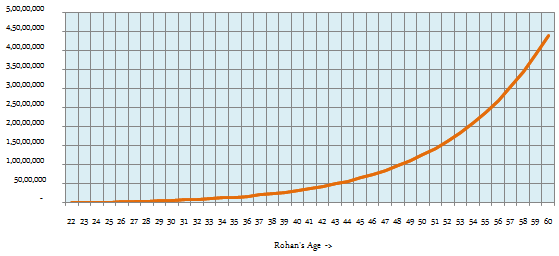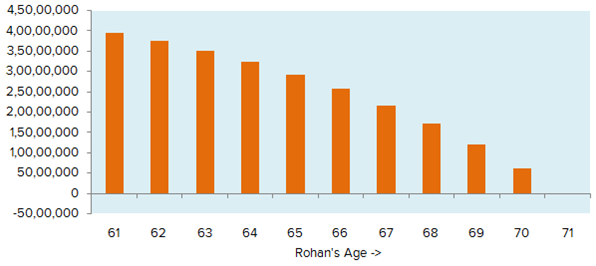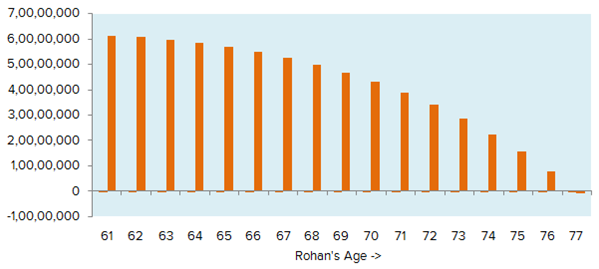Retirement planning: Why should you get serious about it now

Have you seen the Hollywood movie, Wall Street: Money Never Sleeps? If you have seen the movie, you will be able to recall the famous line, “What is your number?” For readers who have not seen the movie, a character named Bretton James (played by Josh Brolin) asks the protagonist, Jeremy (played by Shia LeBeouf), this question. James goes on to explain what he means, “The amount of money, you would need to be able to walk away from it all and just live happily ever after. See I find that everyone has a number and it is usually an exact number, so what is yours”.
As a fresh engineering graduate fresh out of college, working in a large public sector company twenty years back, I also had a number in my head. Many of my friends also had similar numbers in their heads and we would often discuss how, once we reach that number, in terms of savings, we would happily retire from work and do the things that we “love” doing. A few years back, I crossed that number in terms of my savings. I have not retired. Twenty years older and wiser, I have realized that, given my family obligations, lifestyle, inflation, among other things, my current savings is not enough to sustain my family through my lifetime, if I and my wife stopped going to work from tomorrow. So, if you have a number in your head, that number will keep changing as you progress through. The sad reality is that, many of us reach retirement age much before we reach the “number” that will keep us “comfortable” though our lifetimes.
The more troubling observation that I have is, many young and also not so young people, do not even have a “number” in their heads. A college classmate of mine, with a master’s degree in engineering, working in a senior role in one of the largest technology companies in India, told me philosophically that “life always finds a way”. I sincerely hope it does, but I am quite sure that his provident fund and life insurance maturity savings amounts alone will not be sufficient to pay for his membership in one of Kolkata’s most exclusive clubs, his family’s annual European vacation and his other fairly expensive lifestyle choices. Lifestyle is habit forming and I have seen that, it is quite painful to downgrade simply due to financial reasons. In this blog post, we will discuss why retirement planning is so important from a very early stage of your career.
I think if we go through a fairly simple example, you will realize how complex the problem of retirement planning is. Let us assume that, Rohan is fresh college graduate beginning his career. His take home salary is र 25,000 per month. He saves and invests 10% of his take home salary. His annual increment is 10%. The return on his investment is 10%.
Before we get into the analysis, let us review the assumptions first. His salary is what it is. Generally it is believed that, higher the salary more is the savings in percentage terms. However, it is not always true. It is often seen that, higher the salary more expensive is the lifestyle of the individual. Let us talk about savings rate now. 10% savings rate is not great, but it is not bad either. If you are of Rohan’s age, ask yourself if you regularly save 10% of your take home salary.
Now to annual increment assumption; as per Aon Hewitt survey, the average salary increment in India in 2016 is about 10%. So our assumption is fairly reasonable. Of course, if you get promoted, you will get a bigger hike. In my corporate experience I have seen young people getting excited when they get a couple of promotions in rapid succession, but we should bring some realism here. Young people should understand that, promotion opportunities become extremely rare once you get to a senior level. If you are a top performer, at best you will get 6 – 7 promotions in your entire career, spanning nearly 40 years. If you are “C” level material, then you will get more opportunities and who wants to believe that they are not “C” level material, but in every company, you should understand that, there are only a few “C” level executives.
In our example, we have assumed average career progression for Rohan. For your financial planning purposes, you should also be conservative and assume the same; otherwise, you may get disappointed if things do not work out financially, as per your aspirations. Finally, a word on investment returns; we have assumed 10% return on investments. Most assured return investment products give 6 – 8% returns on a pre-tax basis. Equity, as an asset class, has historically given higher returns, but for most investors, equity forms a small portion of their savings amount. Historically, equity has formed only 4 – 5% of household savings in India. Even if we assume that, Rohan invests a much higher amount, say 25%, in equity (average returns assumed to be 15%) and the balance in assured returns fixed income products (average returns assumed to 8%), his weighted average return on investment works out to be around 10%.
Let us not see how much will Rohan’s retirement planning investment will grow during his career. The chart below shows the growth of Rohan’s retirement planning investment.

In this example, Rohan will accumulate nearly र 4.4 crores by the time he retires. To Rohan who takes home र 25,000 per month, र 4.4 crores may seem to be a big amount. But is it really? But financial planners will ask Rohan to factor in two things, inflation and lifestyle. Readers, who remember the 80s and 90s well, will know that cost of many items in the urban consumption basket has gone up by at least 7 to 8 times in the last 25 to 30 years. Also, remember your lifestyle 25 years back and compare it with your current lifestyle. Once you combine, inflation and lifestyle changes, many of you will realize that, how much you are saving right now, will not be sufficient 30 – 40 years later.
Going back to our Rohan example, he will have nearly have र 4.4 crores at retirement. He and his spouse, will have to live on his retirement savings for the rest of their lifetimes, once Rohan retires, assuming they are a single income household. Let us now consider how much income, Rohan and his future spouse will need during their retirement years. Today Rohan’s monthly expense is just र 22,500. But when he is around 60, assuming that Rohan’s savings rate will still be 10%, his monthly expenses can be as high as र 8.5 lacs. Some readers may argue, why should assume Rohan’s savings rate will still 10% when his salary will be much higher. Our argument will be:-
- Firstly, inflation is a reality which we cannot ignore. In fact, the inflation of the urban consumption basket, over the last decade or so, has been higher than what the official CPI number is.
- Secondly, Rohan’s expenses will increase faster than inflation because today Rohan is single, but when he is married and has children, his expenses will naturally increase further.
- Thirdly, as Rohan’s salary increases, the lifestyle of his family will also improve. For example, in his twenties, Rohan and his spouse may use a two-wheeler for their regular commute. Later as his salary and family increases, he may upgrade to a small car. Finally, when his kids are older he may upgrade to an SUV. It is not just the cost of the vehicle that goes up with each upgrade; the operating expenses (fuel, maintenance etc) will also go up. It is same with accommodation. Today, Rohan might be living in a rented apartment. But once he gets married and has children, he will want to buy his own house. Usually, the EMI of a house is much more than the rent of a similar house. As Rohan’s kids grow older, he may want to move to move from a 2 bedroom apartment to a three or four bedroom apartment, which in turn will have even higher EMIs and monthly maintenance expense.
Therefore, while one can argue that savings rate will increase with salary, there are also challenges as discussed above. Financial planning prudence suggests that, we avoid making optimistic assumptions and be conservative as far as possible.
Let us now go back to what Rohan’s living expenses will be when he retires. As discussed earlier, when Rohan is around 60, his monthly expenses can be as high as र 8.5 lacs. But in this post, we will not be ultra conservative and try to be as realistic as we can. The 50s is usually the stage of life, when our salaries are at their highest, but our expenses are also at their highest. In addition to home loan servicing, this is also the stage of life, when we pay for our children’s higher education, their wedding etc. Hopefully, by the time Rohan retires, he will be debt free and his children will be settled in their individual lives.
In this example, we have assumed that, Rohan’s post retirement expenses will be only 50% of his average expenses in his 50s, which means that his estimated monthly expenses on an inflation adjusted basis will be around र 3.5 lacs. Readers should note that this is just a ball-park estimate. While some financial obligations like, debt servicing, life insurance premiums, children’s education and wedding go down by the time you retire, there are incremental expenses that you need to factor in. For example, when you are working, you and your family may be covered under your employer group health insurance schemes.
But when you retire you may lose the health insurance cover, especially if you work in the private sector and pay for health insurance out of your own pocket. It is quite possible that your children’s future employers will cover the health insurance of their parents too, but you should not count on it; on the contrary you should plan for paying your Mediclaim premium yourself.
Further, with advancing age medical expenses invariably tend to increase. Not all medical expenses, like your regular doctor visits, medicines etc are covered under Mediclaim (Mediclaim only covers hospitalization). Therefore, you should plan for these incremental expenses too.
Let us now, go back to Rohan’s example. Rohan will have around र 4.4 crores of retirement corpus and his monthly expenses are around र 3.5 lacs in our example. Let us now see, how long will Rohan’s corpus last? We need to factor in two things in this analysis. Firstly, we need to make assumptions around investment returns and secondly, we need to include the impact of inflation. Let us first discuss Rohan’s expected investment returns. Since his investment is the only source of post retirement income for Rohan, normally he would not want to take risks with his investment.
In other words, he is likely to invest it in risk free investment products. The risk free rate in our country has, historically, been between 7 to 8%. If our inflation rate declines in the future, the risk free rate is also likely to go down, but for the purpose of this analysis, let us assume it will be 8% on a pre-tax basis. A big disadvantage of risk free investments for retired people in India is that, it is fully taxable. Let us assume on a post tax basis Rohan’s return is about 6%.
Let us now discuss inflation. Rohan’s capital is fixed but his expenses are not; Rohan’s expenses will increase with inflation. If Rohan’s annual inflation adjusted expenses are higher than his post tax return on investment, over a period of time, his capital will get eroded. Let us see, how quickly his capital erosion takes place, if we factor in an inflation rate of 5%.
The chart below, shows how long Rohan’s capital will last post his retirement, given the above assumptions.

You can see that, Rohan’s capital gets diminished to zero, even before he reaches the age of 71. Retired lives are much longer. Thanks to improved healthcare retired lives are much longer now, with many people living up to 85 to 90 years. In the above example, Rohan runs out of capital and loses his financial independence at the age of 70 only. Therefore, he has to be dependent on someone else, e.g. children, for up to the next 20 years of his life beyond the age of 70. Therefore, while it seemed from Rohan’s र 4 crores + retirement corpus, that he will have saved enough, in practical terms, it is not sufficient.
In the example above, it is clear that a 10% savings rate is not enough for Rohan. What if he saved 15% of his take home salary? The chart below shows how long Rohan’s capital will last post his retirement, if he saves 15% of his take home salary.

You can see in the above chart that, while Rohan’s savings last longer than in the previous example, he still loses his financial independence by the age of 76. If Rohan and his spouse live for another 10 years or so, they have to be dependent on someone else for that entire period.
Conclusion (of this part)
Our Finance Minister, Arun Jaitley spoke about converting “India from a pension less society to a pensioned society”. The Finance Minister’s comment suggests that as a society we are considerably behind, as far as retirement planning is concerned. In this example, we saw that Rohan began saving for retirement when he was just 22 years old and still fell short in terms of financial independence, in his retirement years. The reality is that, the vast majority of us do not even start thinking about retirement savings till much later in life. That makes our jobs much more difficult. In the above case, for example, if Rohan started his retirement savings at the age of 35, he and his spouse would run out of money in just 6 – 7 years. When you are working you have regular cash-flows. There is also the next annual increment and annual bonus to look forward to. This gives you a lot of confidence in financial terms. Running out of money during retirement years can emotionally be very stressful. The earlier you start saving, the more you can accumulate through the power of compounding. An early start is the most important aspect of retirement planning. Therefore, it is imperative that, we start our retirement planning, as early as we can in our careers.
You may like to read how compound interest works
In various websites, you have seen advertisements and articles, telling you how just a र 2,000 monthly SIP in an equity mutual fund can make you a Crorepati in 30 years time. After going through the fairly simple analysis in this post, hopefully, you will be able to appreciate that for many middle class Indians, given our rising per capita income and improving lifestyles, simply being a Crorepati, is not sufficient to take care of your post retirement life. While an early start is very important, two other things are also important; how much you save and where you invest. By saving more money, you can create a bigger retirement corpus, which will last longer. But most of our readers will agree that, saving more money is easier said than done. In the next and concluding part of this post, we will discuss how asset allocation can be the most effective strategy in meeting your retirement goals. Please stay tuned........
Mutual Fund Investments are subject to market risk, read all scheme related documents carefully.
RECOMMENDED READS
Sundaram Asset Management Company is the investment manager to Sundaram Mutual Fund. Founded 1996, Sundaram Mutual is a fully owned subsidiary of one of India's oldest NBFCs - Sundaram Finance Limited.
Quick Links
- Interview - Mr. Dwijendra Srivastava - CIO - Fixed Income
- Interview - Mr. Sunil Subramaniam - CEO
- Sundaram Select Midcap Fund: Consistent outperformance makes it a big wealth creator
- Interview - Mr. Sunil Subramaniam - CEO
- Fund Manager Interview - Mr. Krishna Kumar - CIO - Equities
- Sundaram Rural India Fund: This thematic Mutual Fund aiming good long term returns
- Sundaram Equity Multiplier: Long term wealth creation potential
- Our Articles
- Our Website
- SIP one sheeter-Investor Education initiative
- Sundaram Asset Management Singapore
- Returns Calculator
- SEBI Investor Awareness Initiative
- Check your KYC Status
- KYC Forms & FAQs
- Recieve your PIN
- A note on NIGO
- FAQs on RGESS
- FAQs on Direct Plan
- Receive Updates
- Share your views
- Transmission Checklist
- Equity Application Form
- Fixed Income Application Form
- Transaction Slip
- Factsheet May - 2016
- MF Tax Reckoner 2015
Follow Sundaram MF
More About Sundaram MF
POST A QUERY




